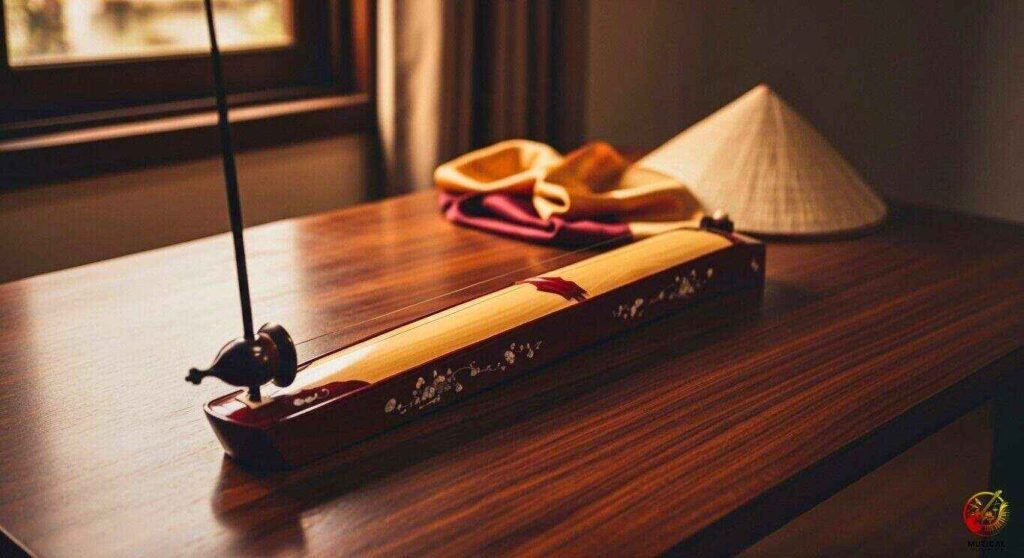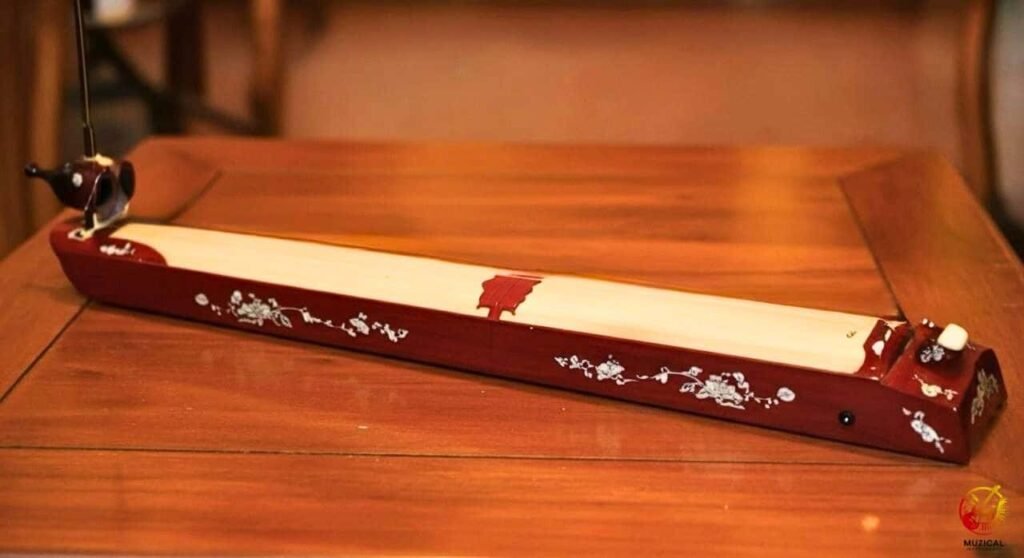What is a Dan Bau? Your Guide to Vietnam’s Magical Single String Instrument
The dan bau is a traditional Vietnamese instrument with a voice unlike any other. Even though it has just one string, it can create sounds so rich and emotional that people often compare it to the human voice.
This simple yet powerful design allows the instrument to “speak” in a way that feels deeply personal and full of feeling. Because of this, the dan bau has become one of the most treasured instruments in Vietnamese music.
In this guide, you’ll learn what is a dan bau? trace its history, see how it’s played, and explore the role it continues to hold in today’s world.
Understanding the Dan Bau: A Closer Look

So, what is a dan bau, really? The dan bau (pronounced “dan bow“) is a traditional Vietnamese string instrument. It is a type of zither, but it is very special because it only has one string, which is why it’s also called a monochord.
Don’t let that single string fool you. It can produce a huge range of beautiful and emotional sounds.
The Main Parts of a Dan Bau
An acoustic dan bau has a simple design, usually made from wood or bamboo. Each part has an important job.
- The Body (Thân đàn): This long, box-like part is a resonator that makes the sound louder and richer. Traditionally, it was made from a single piece of bamboo.
- The Gourd (Bầu đàn): A dried gourd was traditionally attached to amplify the sound. Today, many instruments use a wooden piece shaped like a gourd for the same purpose.
- The Pitch-Bending Rod (Vòi đàn): This flexible handle, often made of buffalo horn, is attached at one end. The string is tied to this rod, and players push or pull it to bend notes and create emotion.
- The String (Dây đàn): The single string, traditionally silk but now almost always metal, runs the length of the instrument.
- The Tuning Peg (Trục lên dây): This peg at the end of the body tunes the string to a specific note.
- The Plectrum (Que gảy): This is a small pick, usually made of bamboo or plastic, used to pluck the string.
Here is a simple table to help you remember the parts:
| Part Name | Traditional Material | Main Job |
|---|---|---|
| Body (Thân đàn) | Bamboo or wood | Makes the sound louder and richer. |
| Gourd (Bầu đàn) | Dried gourd or wood | Helps amplify the sound. |
| Bending Rod (Vòi đàn) | Buffalo horn or bamboo | Changes the pitch of the notes. |
| String (Dây đàn) | Silk or metal | Vibrates to create sound. |
| Tuning Peg | Wood or metal | Tunes the string to the right note. |
| Plectrum (Que gảy) | Bamboo | Plucks the string to make sound. |
The Magic of Harmonics
How does one string make so many different notes? The secret is harmonics.
A harmonic is a special, high pitched, bell-like sound created by lightly touching the string at a specific point while plucking it. The dan bau player does not press the string down. They use the side of their hand to touch these harmonic nodes while plucking. Right after, they lift their hand, letting the clear, glassy harmonic sound ring out. All melodies on the dan bau are made from these special sounds.
Why is the Dan Bau So Important?

The dan bau is more than just an instrument; it is a cultural treasure in Vietnam with a history stretching back over a thousand years.
It was originally played by blind street musicians (called xẩm) and was beloved in the countryside for its gentle, sad sound.
A Voice for the Heart
The most special thing about the dan bau is its ability to sound like a human voice. The Vietnamese language is tonal, meaning a word’s pitch can change its meaning.
The dan bau can imitate these tones perfectly. The pitch bending rod allows the player to slide between notes smoothly, just like a singer. This makes the music deeply emotional and expressive, which is why people say the instrument can “speak” or “sing.” It is the soul of Vietnamese folk music.
From Folk to Modern Music
For a long time, the dan bau was mostly a folk instrument. In the 20th century, musicians began creating electric versions.
The electric dan bau uses a magnetic pickup, like an electric guitar, to send the sound to an amplifier. This allowed it to be played in large concert halls and with modern bands. Today, the dan bau appears in all kinds of music, from traditional orchestras to pop and jazz.
Here’s a comparison of the two types:
| Feature | Acoustic Dan Bau | Electric Dan Bau |
|---|---|---|
| Sound Volume | Quiet, best for small rooms. | Loud, can be used in big concerts. |
| Sound Source | Natural vibration of the wood body. | Magnetic pickup and amplifier. |
| Appearance | Often made of natural bamboo/wood. | Can be made of many materials, has wires. |
| Best For | Traditional folk music, personal playing. | Modern music, playing with bands. |
How to Play the Dan Bau: A Beginner’s Guide

Learning the dan bau takes patience, as the two hands must do very different things at the same time. Let’s break down the basic steps.
Step 1: Getting the Right Posture
The dan bau is usually placed on a small table in front of you. Sit comfortably with a straight back, so you can easily reach the instrument without stretching.
Step 2: The Right Hand and the Plectrum
Your right hand holds the plectrum (pick) to pluck the string and create harmonics.
- Holding the Plectrum: Hold it firmly between your thumb and index finger.
- Creating Harmonics: This is the key. Use the side of your right hand (below the pinky finger) to lightly touch the string at a harmonic node. At the exact same moment, pluck the string with the plectrum. Immediately lift your hand so the note rings out.
Different notes are made by touching the string at different spots, which takes practice to find by ear.
Step 3: The Left Hand and the Bending Rod
Your left hand controls the pitch-bending rod to add the “singing” sound.
- Holding the Rod: Gently hold the rod with a relaxed grip.
- Pushing the Rod: Pushing the rod away loosens the string, lowering the pitch.
- Pulling the Rod: Pulling the rod towards you tightens the string, raising the pitch.
With small, controlled movements, you can create vibrato (a wavering sound) or glissando (a smooth slide between notes).
Step 4: Putting It All Together
The real skill is coordinating both hands.
- Your right hand finds a harmonic spot and plucks the string.
- Your left hand holds the bending rod to set the starting pitch.
- As the harmonic note rings, your left hand moves the rod to bend the pitch and shape the melody.
Beginners should focus on getting a clean harmonic sound first before adding movement with the bending rod.
Here are some common mistakes that beginners make:
| Mistake | Why It’s a Problem | How to Fix It |
|---|---|---|
| Pressing the string down | This kills the sound and prevents a clear harmonic. | Touch the string very lightly, like a butterfly landing on it. |
| Leaving the hand on the string | This stops the note immediately after you pluck it. | Lift your hand off the string the instant you pluck it. |
| Using too much force on the rod | This makes the pitch inaccurate and can damage the instrument. | Be gentle. Use small, controlled movements with your wrist and fingers. |
| Bad posture | This can cause pain and make playing harder. | Sit up straight and ensure the instrument is at a comfortable height. |
The Dan Bau’s Future
The dan bau has come a long way from the streets of Vietnam. Thanks to talented artists like Pham Duc Thanh, it is now known around the world.
Even in modern music, the dan bau keeps its soul. It reminds listeners of the beauty of Vietnamese culture and tradition. Whether playing an ancient folk song or a modern jazz piece, its voice is unforgettable.
Final Thoughts on This Amazing Instrument
Now you have an answer to the question, what is a dan bau. It is a single stringed instrument that holds the heart of Vietnamese music. From its simple parts comes a sound that is complex, emotional, and deeply human.
If you ever get the chance, listen to a recording or a live performance. You will be amazed at the beautiful music that can come from just one string.
FAQ: What is a Dan Bau?
1. Is the dan bau hard to learn?
Yes, it is difficult. Getting a clear harmonic sound while coordinating both hands and controlling the pitch-bending rod requires a good ear and much patience.
2. What does a dan bau sound like?
Its sound is unique, often described as a clear, singing human voice. The ability to slide smoothly between notes makes it sound very emotional, as if it’s talking or crying.
3. What kind of music is the dan bau used for?
Traditionally used in Vietnamese folk and court music, it’s now found in many modern genres, including pop, jazz, and film scores.
4. How much does a dan bau cost?
Prices vary greatly. A basic student model costs around $100-$200, while a professional, handcrafted electric instrument can cost several hundred to thousands of dollars.
5. Is the dan bau related to the guitar?
No. A guitar has multiple fretted strings. The dan bau has one unfretted string and produces notes using harmonics and a pitch-bending rod, a completely different technique.
6. Can I teach myself to play the dan bau?
While possible, it’s very difficult. Finding a teacher is highly recommended to learn the unique techniques correctly and avoid bad habits. Online tutorials can also be a helpful starting point.
